Europe’s 2nd largest country of Ukraine is known for it’s stunning Orthodox Christian churches, the mighty Carpathian mountains and beautiful coastline in the form of the Black Sea. However, many people don’t realize that Ukraine is home to some of Europe’s best World War 2 history sites comparable to those in places like Germany, Northern France, and Belgium. The country can provide a wealth of locations for any WWII Europe itinerary.
Modern Ukraine has been independent since 1991, but between then and 1922, the country was part of the USSR. In the summer of 1941, Nazi Germany initiated Operation Barbarossa which was aimed at conquering the Western territories of the Soviet Union. The ideological aim of the operation? Repopulate captured territory with ethnic Germans, the natives would be enslaved or murdered to make way.
On June 22nd, 1941, the Nazi onslaught engulfed the Soviet Socialist Republic of Ukraine. 4 million German soldiers and their Fascist allies stormed across the borders of the USSR in what would become the largest human invasion in history.
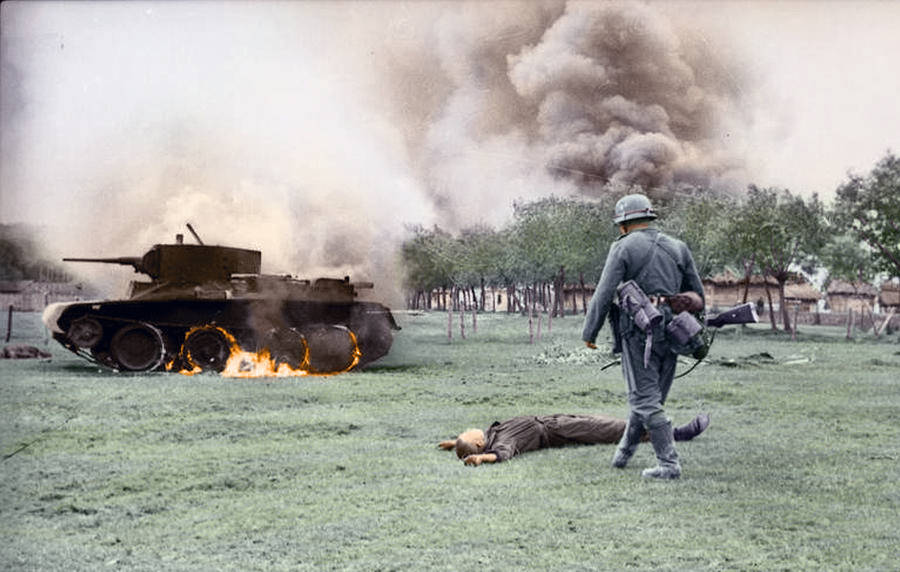
The invading German forces, superior to the Red Army in manpower, technology, and planning, rapidly overran the ill-prepared Soviet Forces. Despite the seemingly inevitable defeat, the Soviets fought monumental and bitter battles against the overwhelming forces of the Third Reich. However, numerous tactical failures led to the Soviets finally retreating back into the borders of Russia.
Thus, between 1941 and 1943, Nazi-occupied Ukraine became known as the Reichskommissariat Ukraine under which the Fascist administration was tasked with pacifying the region as well as exploiting the local population and resources for the benefit of Greater Germany.
The reign of the Reichskommissariat led to the death of millions inside Ukraine, a country that was at the time made up of various ethnic groups including Russians, Belarusians, Polish, Jews, Roma Gypsies, and Crimean Tatars. It’s believed that over 5 million Ukrainian civilians died due to conflict, ethnic cleansing, disease, and famine during WW2.
In 1943, as the tide had turned against Nazi Germany, the Soviets reentered Ukraine and fought a grueling campaign west, further decimating the heavily fought over territory. As a result of the two campaigns for the capture of the country, modern Ukraine is rich in WW2 sights and relics.
On one of our recent trips into Ukraine with the team at Young Pioneer Tours, who provide some of the best world war 2 tours in Europe, we were able to gain unprecedented access to a plethora of WW2 sights in Ukraine, many of which were located far from the beaten path. In this article, we’re going to breakdown each one and provide you with a Reaper Feed insight into each one.
Article Contents
Abandoned German Panzer Tank, Spadchansky
The speed of the German advance during Operation Barbarossa was unprecedented in warfare at the time. The Germans were often advancing up to 50 miles a day which led to many Soviet Units being cut off from the main bulk of the Red Army. As a result, many formed guerilla units behind enemy lines known as partisans. As well as blending in with the local population, Soviet partisans took advantage of the huge areas of dense forest across Ukraine to wage a ruthless irregular war against Fascist forces.
Deep in the Spadchansky forests of Ukraine, a few kilometers from the border of Russia, was the site of bitter fighting between Soviet partisans and Nazi troops during the German occupation of Ukraine. This dense forest was perfect for partisan hideouts and today is home to an epic relic of the partisan front of the Second World War and what should be a staple of European battlefield tours.
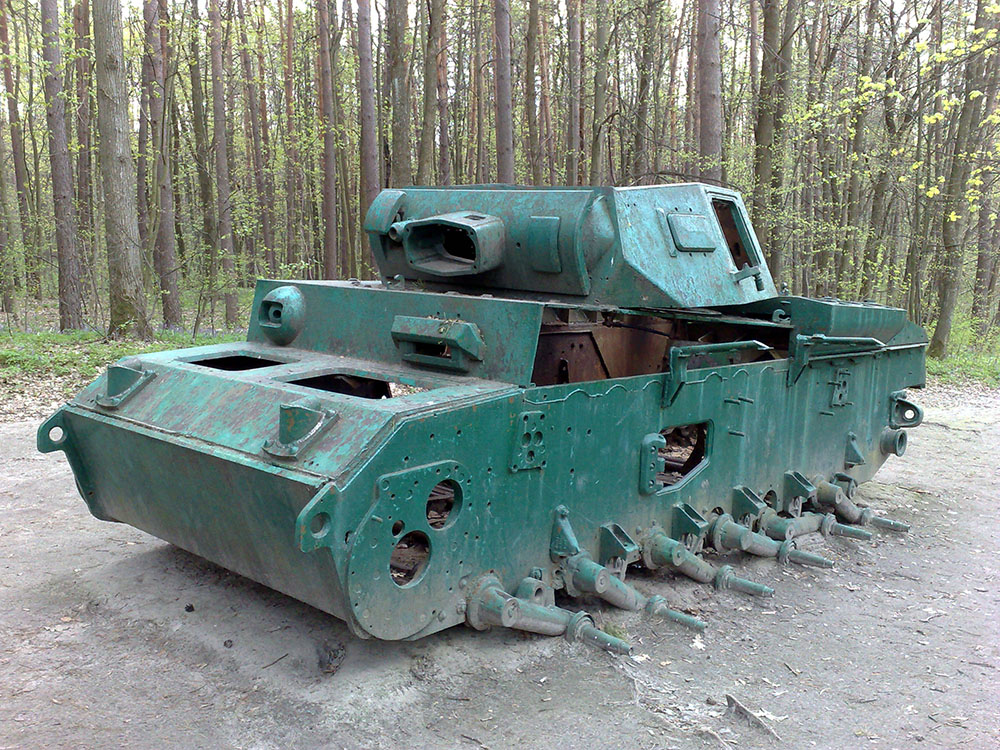
During December 1941, Soviet partisans took on over 3000 German soldiers backed by armored vehicles and artillery. During the ferocious battle, a Nazi panzer was knocked out deep in the woods and simply abandoned. Upon discovering this relic I was reminded of the final battle featured in the movie Defiance, where a similar German Panzer is dispatched to wipe out the retreating partisan fighters in the forests of Belarus.
This relic of Third Reich military engineering, a Panzerkampfwagen III Ausf. J to be precise still lies there to this day. Whilst anything of value has obviously been stripped, thankfully somebody has put a coat of rust-proof paint over the vehicle in order to preserve this incredible piece of WW2 history.
The Bunkers of Hitler, Himmler and Göring
There are few places in the world where you can visit multiple WW2 Sights relating to three of the Third Reich’s most powerful in one day, but in Ukraine, you can. Führerhauptquartier Werwolf was the Nazi High Command Eastern Front headquarters located deep in a pine forest about 12 kilometers north of the Ukrainian city of Vinnytsia, it was the most Eastern HQ ever used by Hitler in person.
Whilst in Ukraine, we headed to a bunker 50km away from the Werewolf complex, known as Hegewald, which was once owned by the feared head of the SS, Heinrich Himmler. It was here that Himmler developed his sinister plan for the East known as “Generalplan Ostâ€. Hegewald was to become the center of the Aryan expansion to the territory of Eastern Europe.
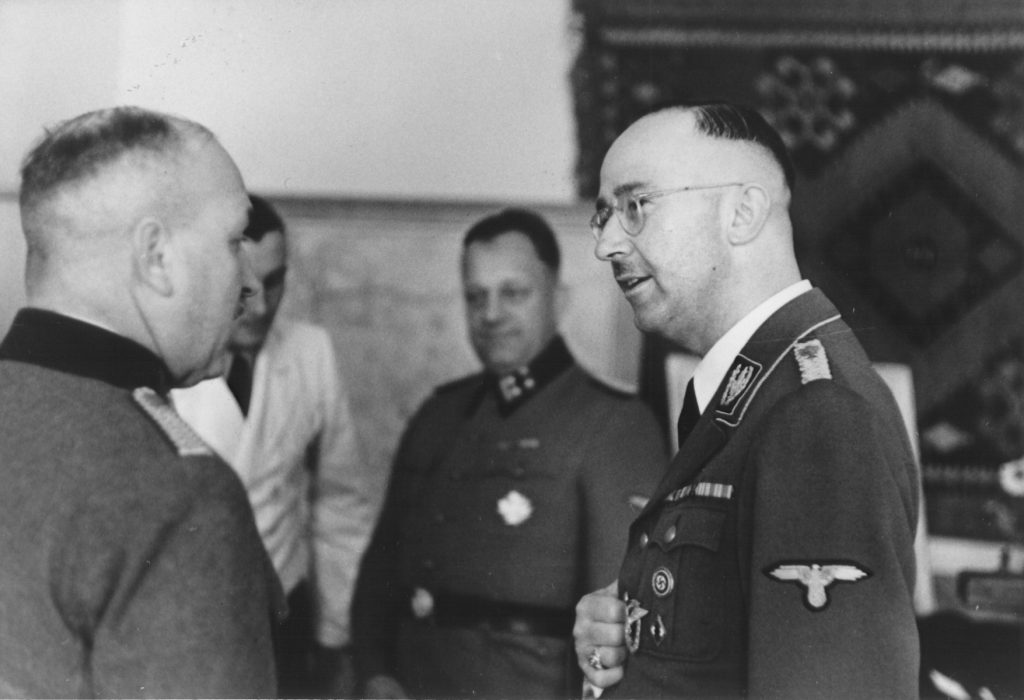
Hegewald was constructed in late 1941 on a former Soviet airfield that had been captured by the Germans. It was fully functioning by the summer of 1942 and consisted of a luxury sprawling villa for Himmler, military barracks, and an airfield. Over 100 high ranking SS officers were stationed at the base, which was protected by a crack force of 1,000 Waffen SS troops and naturally featured a direct line to the Führer himself.
Himmler was frequently based at the Hegewald complex, leading to attention from local partisans. One day, whilst out on a horse ride through the woods nearby, one of Himmler’s personal pilots was abducted by suspected partisans and never seen again. It’s guaranteed he faced a gruesome death. By late 1943, with Soviet forces edging closer, the headquarters was closed down. German forces sabotaged it before retreating west.
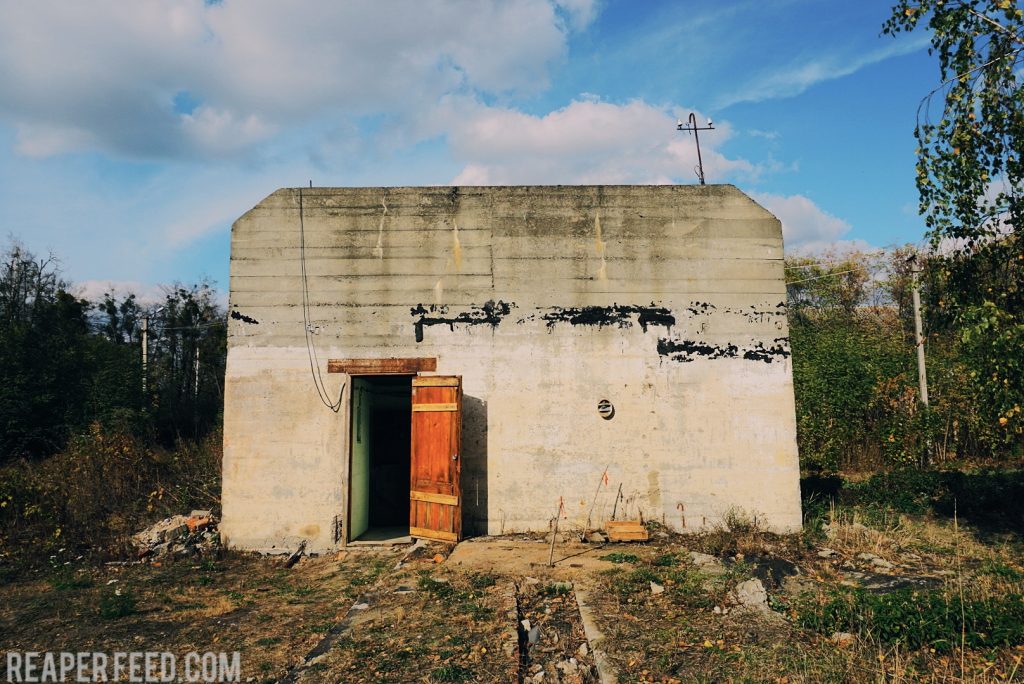
In the post-war years, the Soviets couldn’t destroy what was left of Hegewald and instead built a school up around it. In the post-Soviet years, the school was turned into apartments for local residents, one of whom keeps an eye out for any adventurous tourists looking for the bunker, which is still peppered with bullet holes from the war.
An eccentric and charismatic old Ukrainian man holds the key to Himmler’s bunker as he uses it to store potatoes and farm equipment. He will open it for the Ukrainian equivalent of a $1 bribe. Once inside, he will give you a fast-paced tour (in Russian) and demonstrate that the telephone wires are still in the ground and run to Hitler’s Werewolf bunker nearby.
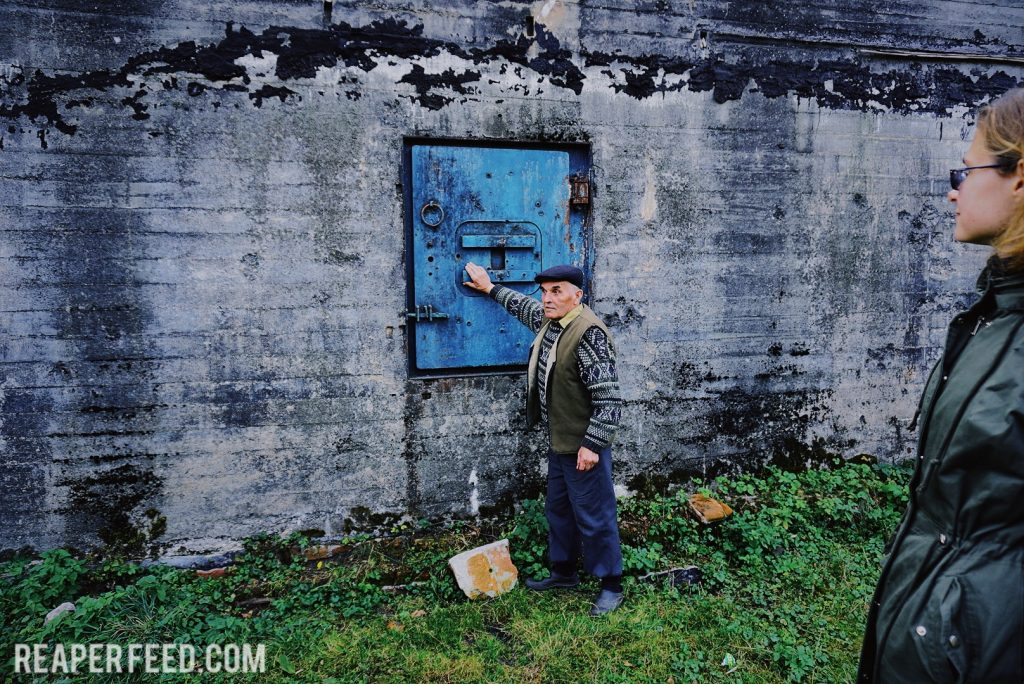
The interior of the bunker is largely empty, apart from some storage creates and potatoes. However, the machine gun hatches still operate and the German-made light switches are still on the walls. In the center is the destroyed entrance to a subterranean tunnel, which apparently leads to another Nazi bunk secretly buried in 1945. We were tempted to start digging, but didn’t have the time or equipment!
Museum of the Great Patriotic War, Kyiv
When arriving in Ukraine, the odds are you will be flying into the capital of Kyiv. Upon entering the city, you’ll likely see an incredible shimmering Soviet monument overlooking the city. This is the iconic Rodina Mat (mother of the motherland) and it marks the site of Ukraine’s national museum of the great patriotic war which is the Soviet-era term for WW2.
Almost in a protective formation around the museum itself is a mass of WW2 weapons, tanks, and planes as well as a good selection of Cold War armaments. Inside is a vast plethora of Second World War artifacts from the Red Army and Nazi occupiers, including a solid bronze eagle from Berlin, as well as captured German trophies laid out on a bed of captured Iron Crosses.
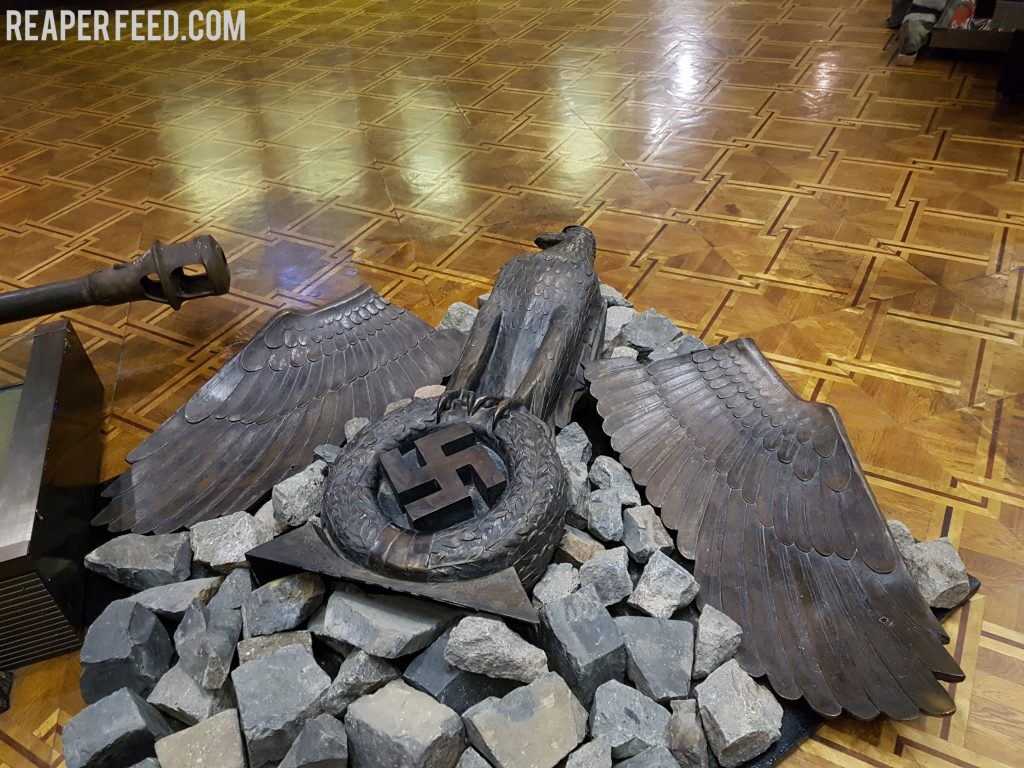
One of the most poignant displays at the museum is an incredibly long dinner table that stretches around 100ft. Each chair has an empty glass of vodka laid out for a soldier that would never return in Ukrainian tradition. The upper floors are home to a unique exhibit on the country’s current civil war, featuring Mad Max-style homemade fighting vehicles and bullet-riddled objects from the battle for Donetsk Airport.
The Odessa Catacombs
In the Black Sea port city of Odessa, also known as the mother city of the Russian Mafia, two monumental battles of the Eastern Front took place when the city was invaded by the Germans and their Fascist Romanian Allies and then recaptured by the Red Army.
Generally regarded as a tourist city for Ukrainians and foreigners alike, there is a far darker side to the city that few people see, but a guide is absolutely necessary to find it. So when we were there, we hooked up with Odessa native and dark history expert, Igor Kalinin who specializes in World War 2 tours. We proceeded to show us the non-tourist side of his city. Igor picked us up in his beautiful Soviet-era Volga car and proceeded to take us underground into the Odessa catacombs.

Stretching for an eye-watering 2,500km, The Odessa catacombs are made up of a seemingly endless labyrinth of cramped tunnels that spread out like tentacles across the city of Odessa and the wider region. The majority of the catacombs were formed from stone mining centuries ago, but after the bloody siege of Odessa in 1941, they soon began to provide a far different purpose. A large number of Soviet troops cut off from the bulk of the retreating Red Army escaped certain death by retreating into the catacombs. They became partisans and launched a guerilla war on the Fascist occupiers above ground.
After issuing us with helmets and torches, Igor took us underground to the former partisan holdouts, still littered with bullets, Soviet flags and helmets. Once there, we sat at a table deep underground to learn more about the war and the unique history of Odessa, as Igor poured us some of his potent homemade Vodka mixed with horseradish which he aptly calls ‘Nuclear Winter’.
The 411 Battery, Odessa
After becoming the battleground multiple times in WW2, Odessa naturally has as much WW2 relics above ground as it does below. Upon leaving the catacombs, our expert guide Igor took us to our next stop: the 411 Coastal Battery Museum which now forms part of a large memorial complex and a public park on the outskirts of downtown Odessa.
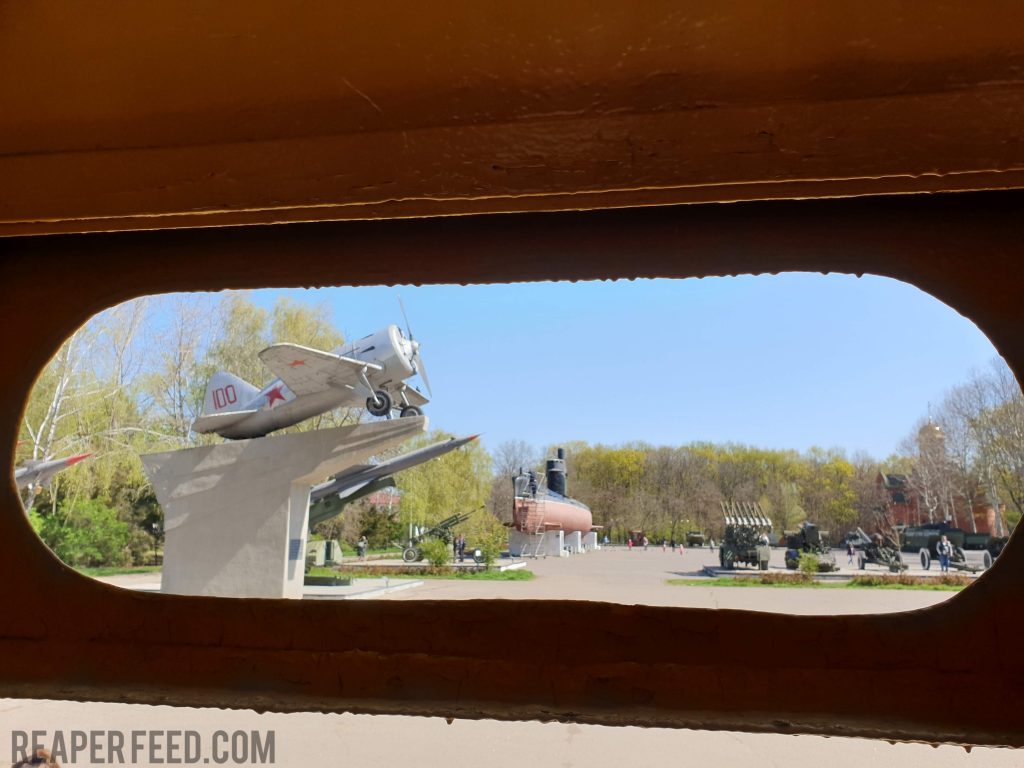
The 411 coastal battery was constructed by the Soviets in 1935 to defend the strategic port city and marine base of Odessa. During the siege, which was carried out mostly by Fascist Romanian troops alongside Germans, the battery rained down an incredible 200,000 shells on the invaders. When it became clear that the city was lost, Soviet Rear Admiral Gavriil Zhukov ordered the battery to be destroyed to prevent it from falling into enemy hands.
Today, the area is full of rare WW2 vehicles including an enormous Soviet submarine, a homemade Soviet tank, and even a tram car that still functioned as a commuter route during the siege albeit with an anti-aircraft gun attached to act as a mobile battery whilst it worked. There is also a small Soviet-era museum full of various artifacts on site.
Bunker in the Rock, Korosten
Our adventures through Ukraine took us 150km outside of Kyiv to the city of Korosten home to a 1930s era bunker which was codenamed ”the Rock”. The bunker was built in solid granite and was rumored to have been personally built for Josef Stalin himself.
As WW2 engulfed the country, Nazi forces took over the bunker complex and used it as storage. The exact purpose the Soviets had for the bunker remains unknown to this day and all documents related to the bunker are classed as top secret and stored under lock and key in Moscow until the year 2039, so sit tight!
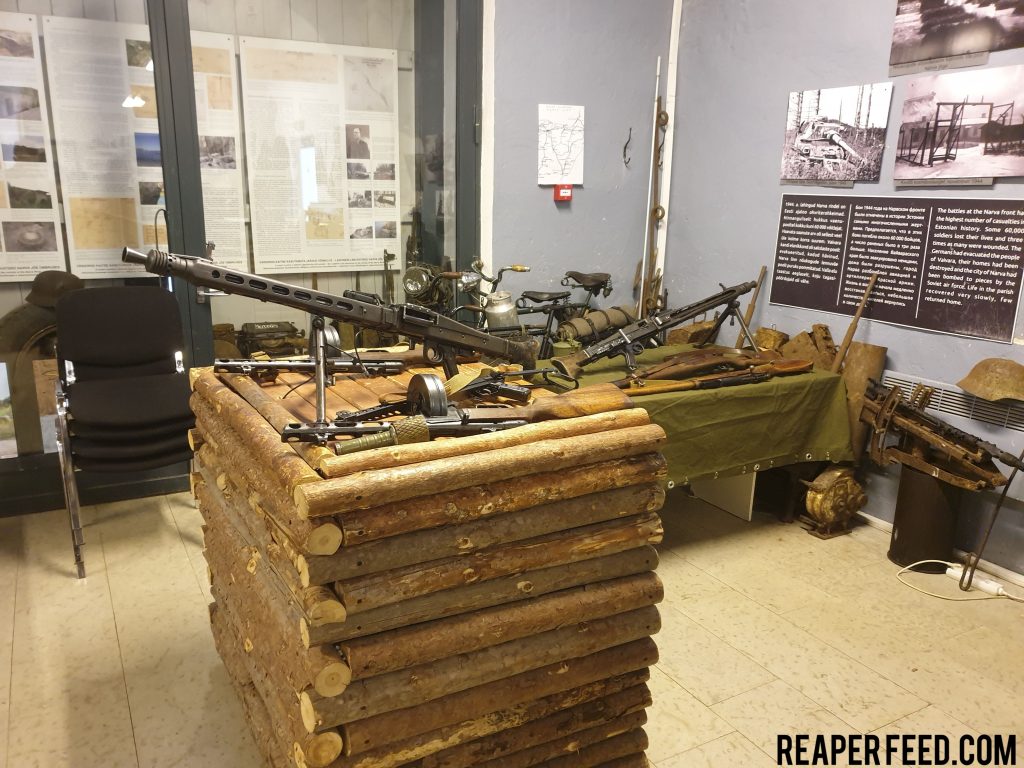
Our visit got off to a rocky start when we found the museum unexpectedly closed as the proprietor was celebrating a birthday party somewhere nearby. Nonetheless, after a quick phone call, he appeared in front of us, slightly tipsy and holding a giant bunker key, we were in!
Inside the bunker is a mass of Soviet military relics including busts of Stalin and red phones that once provided a direct line to the Kremlin. In one of its many rooms, we found a display of discarded Nazi equipment including SS daggers and a stockpile of Nazi weapons including the infamous MG42 heavy machine gun!
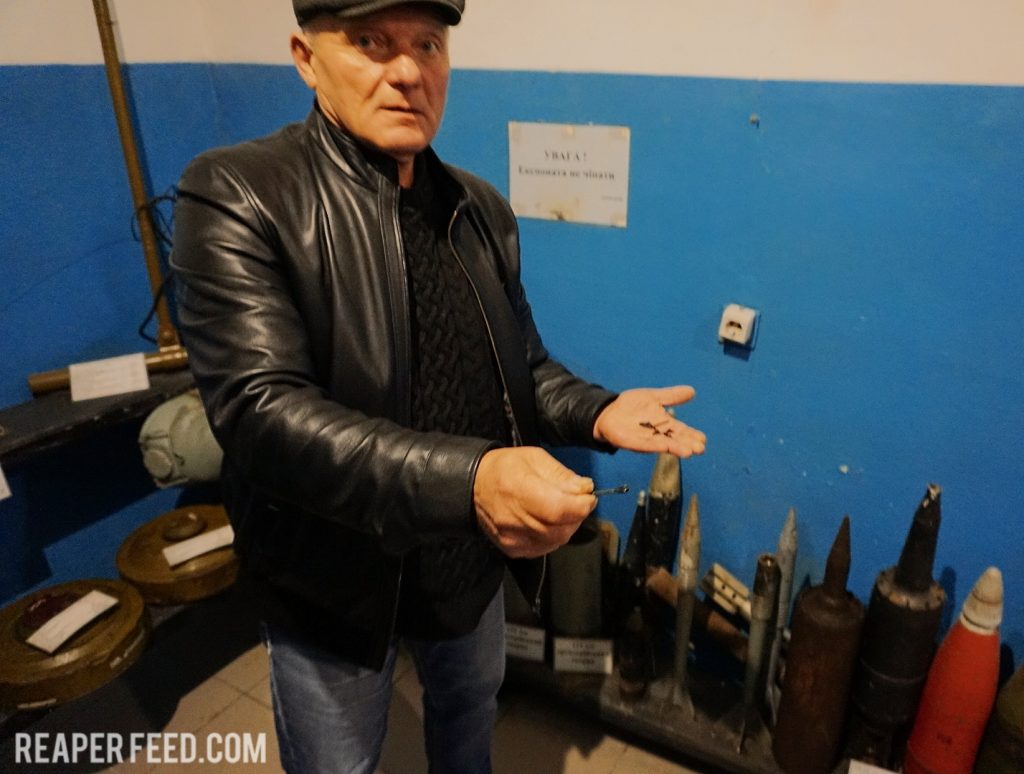
The last exhibit of the museum was focused on Ukraine’s current civil war. Our local guide showed us the various gruesome weapons still in use, including banned flechette rounds which cause horrific injuries. The war in Ukraine’s Donebass region has raged since 2014 and has claimed over 13,000 lives.
Partisan Centre, Spadchansky
Located in the same forests as the destroyed Panzer tank at the beginning of the article, the Partisan centre is located in another sector of Spadchansky Forest and is dedicated to the resistance movement that existed in this area during WW2. Flanked by WW2 tanks and artillery guns, inside the centre is a wealth of information on the Soviet partisan movement as well as various artefacts used in battle by them.
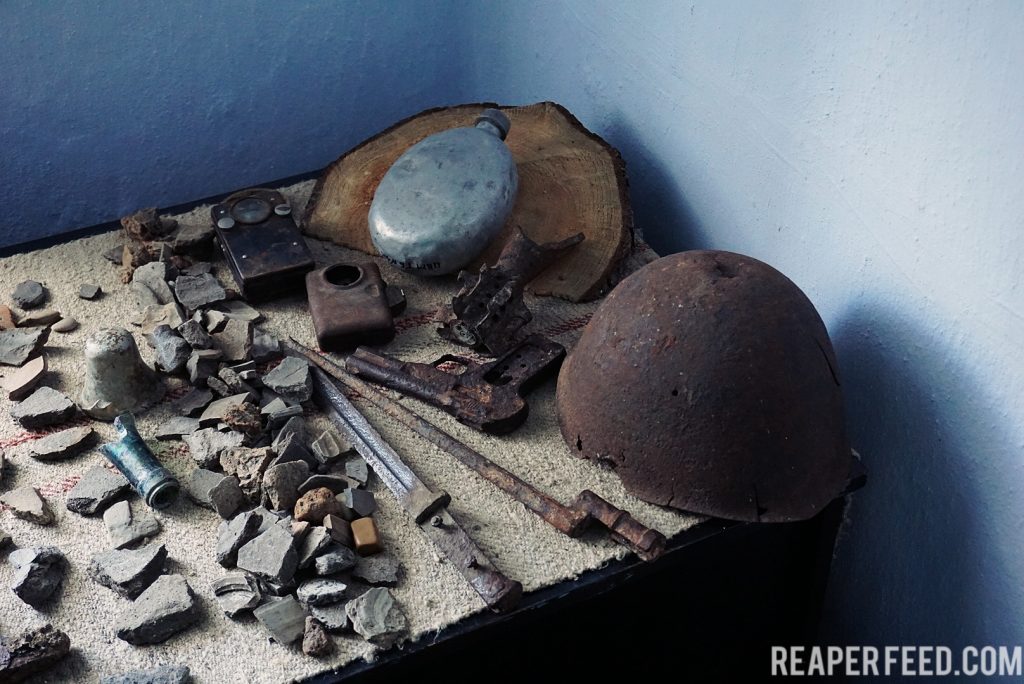
Located closer to Russia than to the Ukrainian capital of Kyiv, the former partisan stronghold is not far from Kursk where the infamous WW2 tank battle took place. Aside from the main museum jam-packed with artifacts from the Second World War, the surrounding area is also full of Soviet monuments as well as surviving bunkers and dugouts used by both the Nazis and the partisans.
Since the revolution in 2014, various Soviet-era monuments are being quickly destroyed across Ukraine. The history of the Soviet Union in Ukraine was far from pleasant, but the blatant physical destruction of history is never acceptable. Thankfully, the Partisan center boasts an alley of surviving Lenin statues rescued from ruin across Ukraine.
The Stalin Line
Construction on the Stalin Line was started in the 1920s with the aim of protecting the western borders of the Soviet Union from any possible attacks from the west. It consisted of a huge amount of concrete bunkers, minefields, barbed wire, and gun emplacements. It had some similarities to the French Maginot Line, although less elaborate.
After the Molotov-Ribbentrop pact and the subsequent short-lived friendship with Nazi Germany, the USSR expanded its territory and focused on constructing a new defense called the Molotov Line on the Soviet empire’s new borders, leaving the Stalin Line to become neglected and many of its weapons to be moved elsewhere.
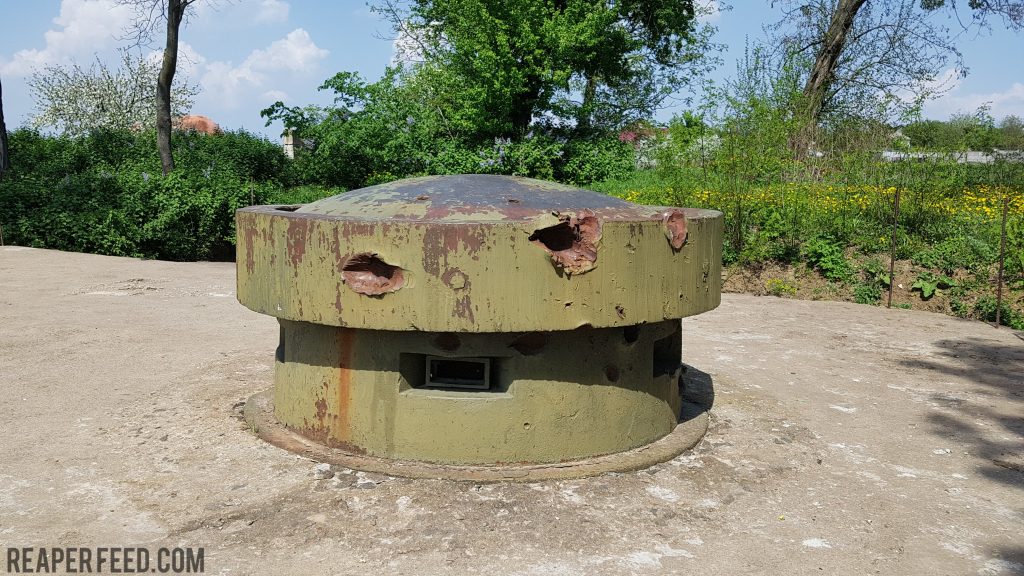
When 4 million men stormed the Soviet borders in Operation Barbarossa, the Stalin Line was undermanned and ill-prepared against the Nazi onslaught. Despite this, the Soviets held out as long as they could in a futile fight against an overwhelming enemy. Following WW2, the Stalin Line was abandoned and today its remains can be found spread out across Ukraine as well as Moldova, Belarus, and Russia.
We hooked up with Aricio, an expert local guide and founder of the Soviet Wonders tour company, and started a road trip to find the remains of this huge fortification. Aricio knows the defenses like the back of his hand and we were soon traversing dense forests and wondering through forgotten villages in search of war-ravaged bunkers. Each one had a different style as many were recycled from various countries of the Soviet Union.
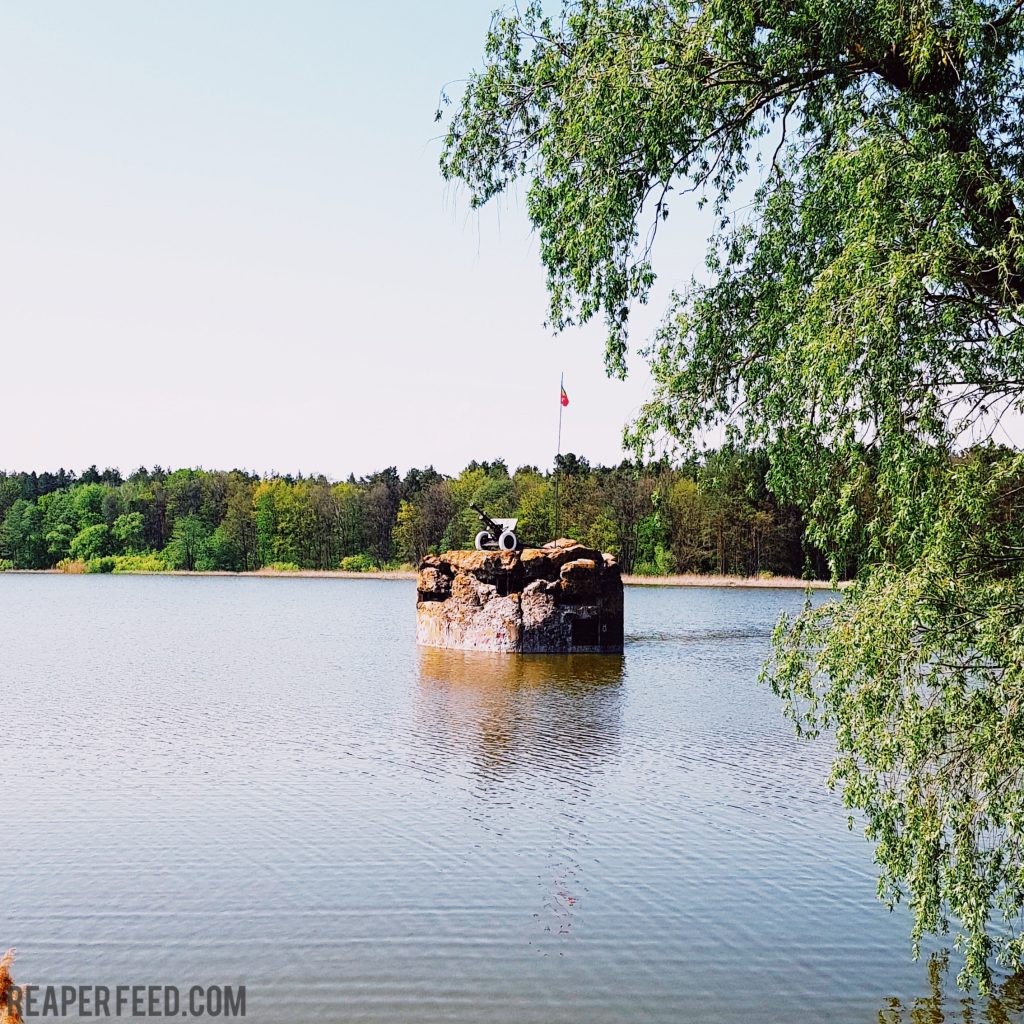
Many of the bunkers had notably dark stories, including one which was situated in the middle of a lake and left behind as the Germans advanced, with Soviet soldiers left entombed inside. The Germans returned a few weeks later to find the emaciated crew clinging to survival having run out of supplies. The Germans promptly burned them alive with a flamethrower. One of the countless stories of horror from Operation Barbarossa, that we know of.
Saur Mogila, Donetsk
This location is, unfortunately, east of the frontline in the country’s civil war, so is not recommended for travel. However, Saur Mogila marks the site of one of Ukraine’s most brutal battles in both WW2 and in 2014 during the Ukrainian Civil War.
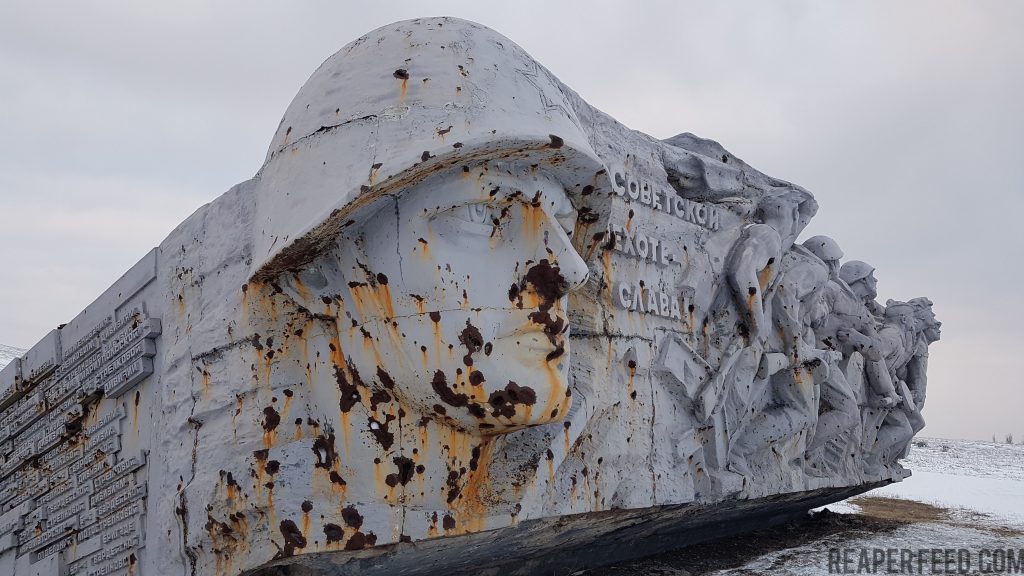
In World War II, Saur Mogila was the focal point of intense fighting due to its strategic location on a hill in a mostly flat landscape. In 1963, twenty years after the Soviet Red Army recaptured the territory, a concrete and steel monument was built on top of the hill. The monument was made up of an obelisk with a statue of a Soviet soldier and huge sculptures built along the path leading up to the obelisk. The quintessential stern-faced Soviet soldiers immortalized in concrete memorialized the Soviet soldiers involved in the battle.
In 2014, as civil war erupted in the Eastern regions of Ukraine, Saur Mogila was captured by pro-Russian separatists due to its strategic high location and its proximity to the Russian border. The separatists managed to shoot down two Ukrainian fighter jets flying over the monument using an anti-aircraft system. Shortly after, the area was brutally fought over and changed hands between separatists and Ukrainian forces at least 8 times before finally falling under separatist control. Much of the monument was destroyed, but around 50% remains today, albeit bullet-riddled.
Private Military Bases
Across Ukraine, there are a number of private military bases owned by everybody from military reenactment groups to active militias fighting on the frontline of the country’s civil war. These bases are often home to a large array of military weapons, relics, and battle tanks from WW2 and the Cold War. For the right price, the owners of such based will gladly let you in for some fun.
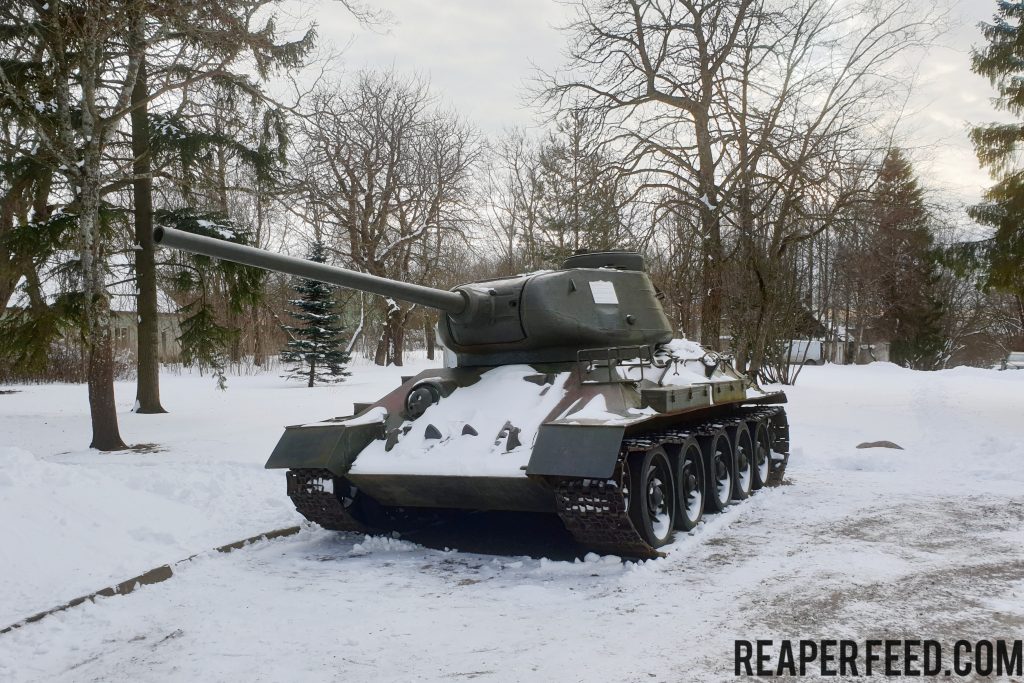
Alongside an array of Cold War vehicles, it’s possible to drive original T-34 tanks from WW2 at these bases for a couple of hundred dollars which works out very cheap when spread out between a group. The Soviets produced countless variants of the T34 and Ukraine was a hotbed for the manufacture of such weapons, meaning they’re still plentiful today, but difficult to maintain.
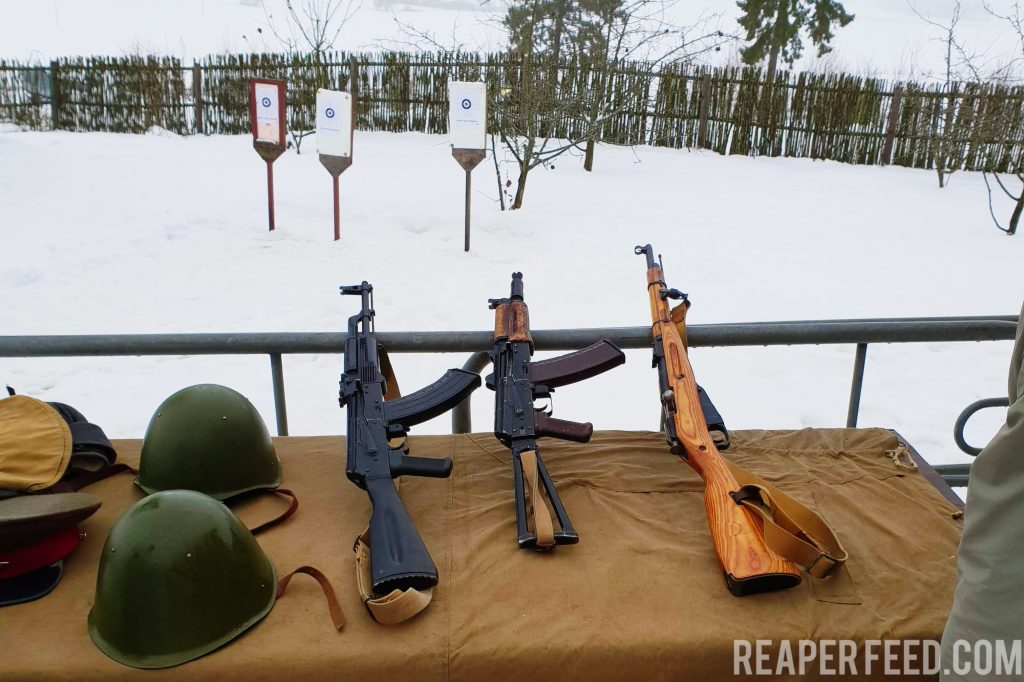
These bases are often always home to a range of weapons from the present all the way back to the 19th century. On our visits to a couple of tank driving bases, we’ve seen MP-40s, Mosin Nagants, and Luger firearms available for firing, alongside the ubiquitous Kalashnikov and SVD rifles.
We hope this article has inspired all of you WW2 buffs to visit the fascinating country of Ukraine. For unbeatable tours through epic WW2 sights across Ukraine and the rest of Europe, be sure to check out the European tour section of Young Pioneer Tours who provide affordable private and group tours throughout the year.
For similar articles on WW2 sights around the world, check out Reaper Feed’s Military History Department!














